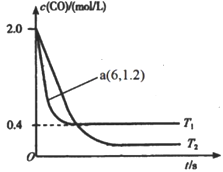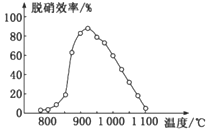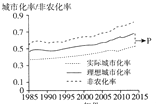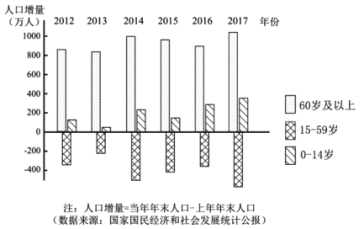高考试题
These films follow seven children from seven different countries. This 12-year project began in 2006,when the children first started school. "This is something we could do to help the education crisis in the world,"said producer and writer Judy Katz. “Documentary film-makers can get deeply involved in a problem and do something about it.”
More than 100 million children will never set foot in a school. Sixty percent of those children are girls. Cheryl Faye,head of the UN Girls Education Initiative,spoke about the many factors that prevent girls from getting an education. One problem is the long distance many children must travel to get to school. Also,girls in many cultures are traditionally expected to marry early and work to help their families. “We need to make a special effort for girls,”Faye said.
As part of the UN's Millennium goals,the organization wants every single child to get at least an elementary education by 2018.
Students from Lawrence Middle School in New York were deeply moved after they saw the film. The seventh grade class is raising money to help build a library on the outskirts of Nairobi,Kenya(肯尼亚),where Joab-a child in the documentary-lives. The class teacher,Karen Weiner,and the class are known in their school as the “Kenya crew”. All the kids were really happy to support Joab and said they felt great about their fund-raising efforts. Like the seventh graders at Lawrence Middle School,kids can work together to make a difference in places like Nairobi. By raising money for education,kids can help children on the other side of the world have a chance of a better,happier life.
【1】What's the purpose of the UN screening the documentary film Back to School?
A.To raise funds for global education.
B.To raise awareness of the need for global education.
C.To encourage all the children to come back to school.
D.To show the achievements which have been made in the past few years.
【2】Special efforts should be made for girls because ____________
A.sixty percent of the children in the world are girls
B.more than 100 million girls will never go to school
C.most of the girls are tired of going to school
D.more than one half of the children who never go to school are girls
【3】Which of the following could NOT be the factor that prevents girls from getting an education?
A.Long distance from school. B.Being born weak.
C.Helping work for the family. D.Early marriage.
【4】Why are the class teacher,Karen Weiner,and the class considered as “Kenya crew” ?
A.Because they are trying their great efforts to raise money for the education of Kenya Children.
B.Because they are actors in the documentary film Back to School.
C.Because they are mostly from Kenya,where the child in the documentary lives.
D.Because they all have the same experience as Joab,the Kenya child.
【5】The last paragraph mainly discusses__________________
A.American middle school students' desire to go to Kenya
B.the content of the documentary film Back to School
C.an example of being inspired to take action after seeing the film
D.how students from Lawrence Middle School raise money for their education

A. 国际贸易总体发展缓慢
B. 经济危机的破坏性增强
C. 世界贸易缺乏制度构建
D. 贸易壁垒危及自身利益

(Ⅰ)求证:
(Ⅱ)求二面角
(Ⅲ)若
据此完成下列各题。

【1】关于图中现象及主要成因对应正确的是
A. 道路上无积冰,但桥面有大量积冰--桥面吸收大气辐射较少
B. 道路上无积冰,但桥面有大量积冰--路面释放地面辐射较多
C. 道路两旁的樟树受损明显--根系薄弱
D. 道路两旁的樟树受损明显--枝叶茂盛
【2】图中桥梁两侧扶手用青石(又名石灰石)制作的主要原因是
A. 青石质地坚硬,能长时间保存 B. 青石内部结晶完整,纹理美观
C. 青石更易雕琢,美观大方 D. 青石地壳中储量少,名贵高雅
【3】据图推测图中小车最可能的行进方向和河流流向是
A. 河流由西向东流 B. 小汽车由北向南行驶
C. 河流由南向北流 D. 小汽车由东南向西北行驶
(1)李白《蜀道难》中“__________,__________”两句,描绘蜀道之高危,仿佛在星辰之间穿行,令人空自嗟叹。
(2)苏轼《赤壁赋》中描写箫声缭绕不断绝的句子是 “__________,__________”。
(3)周敦颐《爱莲说》中,用“__________,__________”描写莲花的高洁质朴,表达对莲花的礼赞。
(1)煤燃烧产生的烟气中含有氮的氧化物,用CH4催化还原NO2可消除氮氧化物的污染。已知:
①CH4(g)+ 2NO2(g)= N2(g)+CO2(g)+2H2O(g) △H=-867.0kJ/mol;
②N2(g)+2O2(g)= 2NO2(g) △H=+67.8 kJ/mol;
③N2(g)+O2(g)=2NO(g) △H=+89.0 kJ/mol
则CH4催化还原NO的热化学方程式为__________________________________。
(2)在汽车排气系统中安装三元催化转化器,可发生反应:2NO(g)+2CO(g)

①据此判断该反应的正反应为____(填“放热”或“吸热”)反应。
②温度T1时,该反应的平衡常数K=_____;反应速率v=v正-v逆=k正c2(NO)c2(CO)-k逆c2(CO2)c(N2),k正、k逆分别为正、逆反应速率常数,计算a处
(3)SNCR-SCR脱硝技术是一种新型的除去烟气中氮氧化物的脱硝技术,一般采用氨气或尿素作还原剂,其基本流程如图:

①SNCR-SCR脱硝技术中用NH3作还原剂还原NO的主要反应为4NH3(g)+4NO(g)+O2(g)=4N2(g)+6H2O(g),△H<0,则用尿素[CO(NH2)2]作还原剂还原NO2的化学方程式为____________。
②体系温度直接影响SNCR技术的脱硝效率,如图所示:

SNCR与SCR技术相比,SCR技术的反应温度不能太高,其原因是__________;当体系温度约为925℃时,SNCR脱硝效率最高,其可能的原因是______________。
A. 多3900元 B. 多3150元 C. 少4050元 D. 少1050元

A. 两对等位基因的遗传遵循基因的自由组合定律
B. 蓝花个体的基因型有aaXBY、aaXBXB、aaXBXb三种
C. F2中花色的表现型及比例是白色:蓝色=13:3
D. F2开蓝花的雌性植株中纯合子所占的比例是1/4
科研人员利用植物体细胞杂交技术培育矮牵牛新品种,技术流程示意图如下。

下列叙述正确的是( )
A .愈伤组织是幼嫩叶片通过细胞分化形成的
B .获得的杂种植株都能表现双亲的优良性状
C .可用聚乙二醇诱导原生质体甲和乙的融合和细胞壁再生
D .用纤维素酶和果胶酶处理愈伤组织以获得原生质体
In the winter of 1910, Dr. Wu Lien-Teh stepped off a train in the northern Chinese city of Harbin. He was there to solve a medical mystery, at great personal risk. Over the past few months, an unknown disease had swept along the railways of northeast China, killing 99.9% of its victims. The Qing Imperial court had sent the Cambridge-educated Dr. Wu north to stop the epidemic.
When Dr Wu arrived in Harbin on Christmas Eve, 1910, he carried little in the way of medical instruments and had only one assistant. One of Wu' s first acts upon arrival was to set up special quarantine(隔离) units and to order lockdowns to stop infected persons from traveling and spreading the disease. He had teams check households for possible cases, and even managed to convince authorities to completely close the railways in the early weeks of 1911. Of particular concern was the upcoming Chinese New Year holiday, which had become a great annual migration of people traveling across the country to see their families.
Thanks to Dr. Wu's efforts, the number of plague victims began to die down, and by March 1, 1911, the epidemic was fully contained. The pneumonic (肺炎的) plague outbreak of 1910-1911 lasted nearly four months, affected five provinces and six major cities, and accounted for over 60,000 deaths. It is clear that without the brave and decisive actions taken by Dr. Wu, it could have been much worse. Had the epidemic gone unchecked, allowing holiday rail passengers to spread the disease to the rest of China could have meant a catastrophic loss of life and possibly a global health crisis.
In April 1911, Dr. Wu chaired an International Plague Conference in Shenyang, attended by scientists from 11 counties including the United States, Great Britain, Russia, Japan and France. They praised Dr. Wu for his handling of the 1910-1911 outbreak. For a time, Dr. Wu was the world's most famous plague fighter, a title be defended in a malaria epidemic in China in 1919, and a return of plague in 1921.
1.What was Dr Wu's mission in 1910?
A.To take personal risk. B.To end an epidemic.
C.To provide medical education. D.To investigate the number of victims.
2.Which of Dr Wu's acts stopped the disease from spreading nationwide?
A.Setting up special quarantine units around the country.
B.Treating infected persons with his medical instruments.
C.Checking households himself for possible cases.
D.Convincing authorities to close the railways.
3.What can we infer from the last two paragraphs?
A.The disease worsened after Mach 1, 1911.
B.60,000 would have died without Dr Wu's efforts.
C.A global health crisis followed the 1910-1911 outbreak.
D.The plague broke out again about 10 years later.
4.What can be the best title of the text?
A.A Plague Fighter
B.A Global Health Crisis
C.The Beginning of the Chinese Public Health System
D.A Plague Outbreak
不少有重大贡献的自然科学家既是科学伟人,又是科学哲人,牛顿从经验主义出发建立起古典力学,爱因斯坦从唯物论出发建立了广义相对论,海森堡受柏拉图哲学的启发,决心寻找反映自然秩序的数学核心,建立了矩阵力学。能解释上述科学史实的是( )
① 哲学是世界观和方法论的统一 ② 哲学的争论引领具体科学的进步
③ 哲学是一种能生产知识的知识 ④ 重大科学研究前沿需要哲学智慧的启迪
A . ①② B . ①④ C . ②③ D . ③④

据此完成下面小题。
【1】图中P对应的是
A. 城市人口 B. 半城市化人口
C. 农业人口 D. 乡村非农人口
【2】图示期间该市半城市化状态呈现
A. 波动上升 B. 逐渐上升 C. 波动下降 D. 逐渐下降
【3】图示期间该城市
①常住人口城市化率低于户籍人口城市化率②户籍人口城市化率低于常住人口城市化率③非农化率高于城市化率与农村中存在非农业活动的人口有关④非农化率高于城市化率与城市中存在从事农业活动的人口有关
A. ①③ B. ①④ C. ②③ D. ②④
阅读短文,按照题目要求用英语回答问题。
I’ve always been creative since I was a little girl. My childhood was filled with arts, crafts ( 手工 ) and music, and every day was an exciting adventure of creation.
Somewhere along the way, however, I lost touch with my creative self. At 21, I landed a job at a big insurance company out of my business degree. I would go to the office, sit at my desk and repeat the same work five days a week 9 to 5. The days were long and tedious . Working this way for one year was painful enough, let alone a lifetime. Before long I decided to make a change.
One thing I had developed an interest in was sewing, so I took a sewing course at a community college. It was only a five-week course but it awakened my interest and got my confidence up.
As I dreamt bigger, I began looking into college courses for Fashion Design and three months later I signed up for a part-time design course. I attended classes two nights a week. Although exhausting, it gave me energy, enthusiasm and happiness.
As it became clearer that fashion was what I wanted to do full time, the reality of my day-to-day work at the insurance company became harder. I felt bored. No energy, no motivation and zero fulfilment ( 满足感 ).
I knew I needed to make a bigger change. After struggling for quite a while, I made a difficult decision—leaving my job and studying my design course full time. Two years later I got my diploma.
The last few years have been exciting because I’ve been following my heart to do what I love. Today I am living a creative life as the designer of my own fashion brand.
Sometimes it’s hard to make a change, but I’m so glad I set the wheels of change in motion with that very small first step because it has led me to where I am today.
1 . What was the author interested in when she was a little girl? (no more than 10 words)
2 . What does the underlined word in Paragraph 2 mean? (1 word)
3 . How did the author feel when she was taking the part-time design course? (no more than 10 words)
4 . What did the author do to get back to her creative life? Give two of the facts. (no more than 15 words)
5 . Do you consider the author as your role model? Please explain. (no more than 20 words)
A. 太子太傅,为古代辅佐天子的大臣。天子年幼或缺位时代理国务。
B. 《孝经》,阐述和宣扬孝道的儒家伦理经典,强调孝的“天经地义”。
C. 乞骸骨,古代年老臣子请求退职的婉辞,意为请求赐还自己的身体。
D. 乡党,古代五百户为党,一万二千五百户为乡。后来指家乡或同乡。

【1】图示反映出当前我国人口
A. 处在高速增长的阶段 B. 总数超过人口警戒线
C. 15—59岁人口比重降低 D. 总数呈现明显下降趋势
【2】我国出台延迟退休年龄政策有利于
A. 缓解人口老龄化 B. 增加青壮年人口
C. 推进养老产业发展 D. 降低社会养老负担
A. 攻击蛋白质降低某些酶的活性
B. 攻击DNA可能引发基因突变
C. 攻击磷脂直接导致中心体损伤
D. 攻击生物膜引发新的自由基产生
(1)求椭圆
(2)若直线
He must have sensed that I ________ (look) at him. He suddenly glanced at me and said quietly, “Why are you staring at me like that?”
①破除品牌授权垄断,激发市场竞争活力
②创新汽车流通模式,构建共享型、节约型流通体系
③优化汽车产品和服务供给,增强消费者理性
④统一消费者购车渠道,降低汽车流通成本
A. ①② B. ①③ C. ②④ D. ③④
| A | B | C | D |
实验 | 新制氯水滴入Na2S 溶液中 | 乙醇滴入K2Cr2O7酸性溶液中 | 饱和FeCl3溶液滴入沸水中 | 草酸滴入KMnO4 酸性溶液中 |
现象 | 产生黄色浑浊 | 溶液由橙色变为绿色 | 液体变为红褐色且澄清透明 | 产生无色气体,溶液紫红色褪去 |
A. A B. B C. C D. D
- 下列各式中:①;②③④⑤分式有【 】A.1个B.2个C.3个D.4个
- 有一首歌唱到“一九七九年那是一个春天”,“一九九二年又是一个春天”,歌中的两个“春天”分别喻指 A.“三步走”部
- “酒与污水定律”是指如果把一匙酒倒进一桶污水中,你得到的是一桶污水;如果把一匙污水倒进一桶酒中,你得到的还是一桶污水。该
- A mother planted many kinds of vegetables in her garden. One
- 下列说法正确的是()。 A. 合金中至少含有两种金属 B. 具有相同质子数的粒子不一定是同种元素 C. 分子是保持物质性
- 从集合A={1,2,3……,20}中任取三个数,使其和能被3整除,则共有取法的种类有_________(用数字作答).
- 根据图示的溶解度曲线判断,下列说法正确的是 ( ) A.甲物质的溶解度大于乙物质的溶解度 B.甲物质的不
- 小面是重庆特色小吃,小面里的下列辅料中富含蛋白质的是( ) A.牛肉 B .辣椒 C .蔬菜
- 如图,直线AB、CD相交于点O,∠BOE=90°。 ⑴若∠1=∠2,求∠COF的度数。 ⑵若∠BOE
- 欧盟是( ) A、欧洲地区的非政府国际组织 B、欧洲地区的政治经济一体化组织 C、世界最大的政府间区域经济合作
- 下列有关实验操作的叙述错误的是( ) A.过滤操作中,漏斗的尖端应接触烧杯内壁 B.从滴瓶中取用试剂时,滴管的尖嘴可
- 返回地球的宇宙飞船为了保护舱内仪器和宇航员,在靠近地面时要打开降落伞进行减速,在竖直减速下落过程中,宇宙飞船的动能
- 此题要求你对一段文章改错。先对每一行作出判断是对还是错。如果是对的,在该行右边横线上画一个勾(√);如果有错误(每行不会
- 读山东省局部地区图,图示地区的经济发展需要注意保护生态环境中的()①湿地资源 ②淡水资源 ③煤炭资源 ④土地资源 A
- (-2)6读作 或 , -26读作 ,它们的和为 .
- 阅读下面的文字,完成1~3题。 夜宿乌镇 朱希和 ①我是在谷雨之后走进乌镇的。高速公路两边的青山绿树烟湖和被称为“江南”
- (7) 曲线y= 在点(1,-1)处的切线方程为 (A)y=x-2 (B) y=-3x+2 (C)y=
- 如图5-7-4所示,物体在离斜面底端4 m处由静止滑下,若斜面及平面的动摩擦因数均为0.5,斜面倾角为37°,斜面与平面
- 3.下列各句中,没有语病的一句是( ) A.我校文化衫设计大赛的参赛者大多是以高二的师生为主,其他年级的师生数量不多
- 宇航员在探测某星球时有如下发现:(1)该星球带负电,而且带电均匀;(2)该星球表面没有大气;(3)在一次实验中,宇航员将



